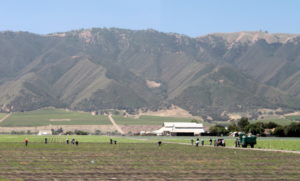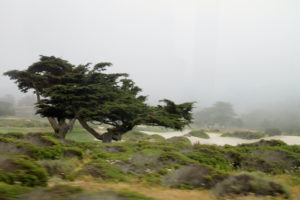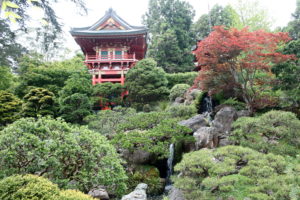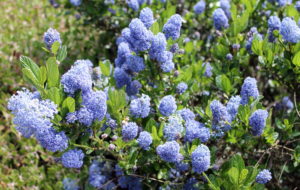Seas of veggies, tractor-following birds, and Clint Eastwood’s oaks
June 20th, 2017
I ran into plenty of intriguing readling material last month on our Lowee’s/Collette tour to northern California. Maybe you’ll be as fascinated by the following as I was:
No-wash produce. The oceanic fields of vegetables in California’s Salinas Valley (where America gets the majority of its cool-season produce) was incredible for its scale and wall-to-wall production.
I was surprised at how closely everything was planted (broccoli 12 inches apart, for example) but even more so by how so much of the produce is packed right in the field. Except for lettuce and small greens, most of it isn’t washed either.
Monterey County Extension educator Evan Oakes said the reason is that “wet shortens shelf life,” which already is a big challenge when it takes three days just to get the produce to stores in the East.
So the aim is to keep the produce (especially rot-prone species such as strawberries and tomatoes) as dry as possible and to get it out of the field and into cooling facilities ASAP.
Winged opportunists. Ever notice how birds show up in the garden after you dig or till a bed? They’re able to hone in on disturbed soil, knowing that the odds of finding worms and/or soil-borne bugs close to the surface go way up.
That same thing happens on a much bigger scale in the Salinas Valley. Birds swarm by the hundreds (if not thousands) behind the tractors as they go up and down the fields.
The birds have no idea about the real purpose of tractors, but they definitely know that when one shows up, it’s buffet time.
Clint Eastwood’s trees. We spent a day in Carmel-by-the-Sea, the quaint coastal town where actor Clint Eastwood was mayor in the 1980s. Turns out that Clint built a golf course nearby that called for the removal of several mature California live oaks.
Averse to cutting and grinding them, Clint instead had them dug, potted and offered for sale. I saw a few of them in what looked like huge, open-topped, wooden crates at Earthbound Farms, the Carmel-based organic farm that introduced America to bagged salad mixes.
The price tag: $40,000 each. Better get your order in now…
Pretty and what else? Another afternoon we toured the American Takii seed facility in Salinas and met breeder Paul Readly, who’s a Penn State grad.
Paul told us about the cool new blue petunia called Evening Scentsation that Takii developed and which won a 2017 All-America Selections honor. “It’s a petunia that smells like a hyacinth,” he says, and was the result of figuring out genes responsible for giving flowers fragrance.
Paul says the market demands “extras” like that nowadays.
“Plants can’t just be pretty anymore,” he told us. “They have to be pretty and something else.”
Leaning trees. I’ve never seen so many horizontal trees as along California’s Monterey Bay.
Cedars and cypress grow along the coast, and they’re battered by such constant wind (not to mention fog) that their leaders (main stems) grow more sideways than up.
It’s an interesting look and another example of how plants do what they have to do in order to survive. In this case, it’s much less likely for a low, spreading habit of a tree to blow over than one standing straight up.
The most famous tree in that area, by the way, is the Monterey cypress dubbed the “lone cypress” because it’s been growing for a century or two all by itself on a cliff along the bay. It’s touted to be America’s most photographed tree, which I don’t doubt considering the throng that was there gawking at it the day I was there to gawk at it.
The garden you didn’t know you saw. Filoli Gardens in Woodside? Never saw it? Never even heard of it? It was superb.
If you ever watched the prime-time soap opera “Dynasty,” you saw Filoli from overhead. The Filoli house and surrounding gardens were shown from the air on the show’s opening credits. It was supposedly where the wealthy Carringtons lived (John Forsythe and Linda Evans).
Interesting factoid: Filoli and its 16 acres of mostly formal Italian-style gardens are built almost directly over top of the San Andreas fault.
A Japanese garden to see. I’d have to say my favorite garden on the trip, though, was the 5-acre Japanese Tea Garden in San Francisco’s Golden Gate Park.
Thanks to brilliant design, this place seems a lot bigger and is loaded with features without feeling crowded – several lakes and bridges, a ceremonial tea house, a moss-carpeted forest, a pond with evergreens pruned like pillows, a Zen garden of raked rocks, and even a Japanese-style café.
Put it on your radar if you’re ever out that way. I’d rate it the second best Japanese garden I’ve ever seen, trailing only the new DeVos Japanese garden at the Meijer Botanical Garden in Grand Rapids, Mich.
Strawberries that don’t quit. Ever wonder how places like California manage to churn out strawberries almost all year long while our picking season only lasts for a month or so?
The secret: annual cultivars. California growers use varieties that produce nearly non-stop for most of a year, then basically burn themselves out and rot with fall rain.
California’s freeze-free climate allows them to yank the current year’s crop, then replant almost immediately with the next year’s one-year plants. By late January, the new ones are producing ripe berries already.
In northern California, though, those earliest crops don’t even go to market because southern California and Florida are already in peak stride.
A variegated lavender. Variegated plants – ones with leaves of two or more colors – are almost always mutants. A “normal” plant puts out a genetic mistake of a stem, and when observant plants people notice, they’ll cut it, root it, and create a new plant that may or may not produce variegated offspring.
A whole lot of plants come in variegated variations, but one I’d never seen with that look was lavender – until I visited the Sunset Magazine test garden in Sonoma.
Growing there was a bushy plant with brilliant creamy-edged blue/green leaves that I didn’t even recognize. Turns out it was lavender ‘Meerlo.’
Unfortunately, it’s a type that isn’t winter-hardy in Pennsylvania (at Zone 9, not even close). So if you can even find it in a catalog or online, it’ll be an annual for us.
My favorite California plant. Finally, under the long list of nice plants we can’t grow in Pennsylvania, I found my favorite California one to add.
It’s called the California lilac, but it isn’t a lilac at all. It’s a totally different species called Ceanothus.
The plant is a broadleaf evergreen shrub with long-lasting, ball-shaped blue flowers about the size of walnuts. They’re true-blue, too… very unusual in a shrub. Most croak when nights drop down 15 degrees or so.











